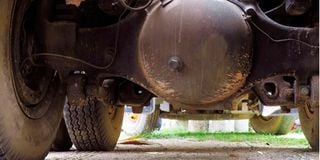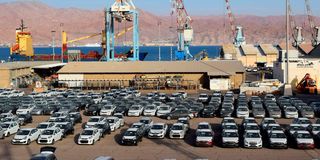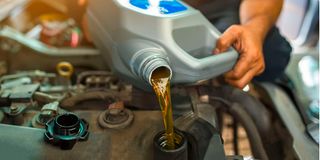Premium
If the rear diff fails, can engaging 4WD get me home?

Depending on what function of the rear diff has failed, you will probably have to remove the rear propshaft to disengage the engine/gearbox from the back wheels so they can “free-wheel” when you get doing again.
Gavin,
On a conventional 4WD estate, if the rear differential fails, can the car be safely driven by engaging 4WD and using the remaining power to the front wheels to keep going?
Raymond.
Short answer: In many instances, Yes, but probably not by simply engaging 4WD. Depending on what function of the rear diff has failed, you will probably have to remove the rear propshaft to disengage the engine/gearbox from the back wheels so they can “free-wheel” when you get doing again.
The diff might have to be gutted or broken gears, but the crown wheel must remain to hold the inner splines of the half-shafts. Although no spares would be required, it could be a long and messy job, requiring good tools and some mechanical knowledge, but this remedy will often get the car home in front-wheel drive.
Longer answer: There are two main causes of diff failure – either lack of oil that has caused extreme heat and damaged the gear bearings, or extreme overload shock that has stripped the cogs or broken their mountings. The pinion gear bearings are the most fragile and likely to fail first.

There are two main causes of diff failure – either lack of oil that has caused extreme heat and damaged the gear bearings, or extreme overload shock that has stripped the cogs or broken their mountings.
The moment of total failure can cause at least one back wheel to lock solid, causing high risk if you are motoring at speed and possible consequential damage to the overall drive train (the gearbox, the prop-shaft universal joints, other gears in the diff and the half-shafts)…and certainly stress the heart-rates of the driver, passengers and other road users.
The first move is prevention. The oil in diffs does not get “consumed” like an engine oil can, but it could leak out if the diff seals, plugs, housing bolts or gaskets are not secure, and it can get degraded if the one-way breathers on the axle tube malfunction and let either deep water or dust/mud get in. Checking the diff oil level and conditions should be a routine item at least at every service. The oil itself can last much longer, but it works at very high pressures and temperatures so be sure to use the recommended weight and grade. Diffs handle the full power of the engine and the full load of the vehicle and the torsional resistance of the wheels. Not an item on which to economise or compromise.
Look out for two early warning signs. Any drips of oil underneath the car where you park (from any part of the car) warrant a prompt check and remedy. Also, a diff that is not adequately lubricated will usually make a whining noise (more noticeable on engine over-run as you release the accelerator pedal). This may continue unchanged for some time and then quite suddenly start to sing like a tortured choir. Check the oil level promptly if you hear a whine. Stop as soon as you can if you hear a big change in that noise.
Should there really be an age limit on imported cars?
Gavin,
The age limit of eight years on imported used cars remains despite suggestions that it might be reduced. What do you think the limit should be? Raju.
Presumably, there are five cardinal policy objectives on this issue:
To make motoring more available/affordable to more people.
To ensure adequate revenue collection.
To reduce the average age and improve the condition of the national fleet.
To close loopholes for corruption and fraud.
To promote a competitive market at all levels.
Just a thought starter.
The best solution in all of these respects might be to remove the age limit completely and zero-rate duty on all vehicles. Instead, charge a flat-rate “imported vehicle tax” according to class, whether brand new, middle-aged or ancient and whether superbly engineered or shoddily made. Without putting the price of older vehicles out of reach (on the local used car market) it would bring the price of newer vehicles within reach of more people. Resultant market forces could achieve all the policy objectives honestly and equitably with very positive outcomes for all legitimate interests – national and individual.
Here’s why and how:
There is nothing magical or mysterious that suddenly happens to vehicles when they get to be more than 2,922 days old. Some are decrepit at less than half that age; others are still in good order when they are more than twice that old.
The decision to allow used imports has done its job – to enable the importation of very large numbers of vehicles very quickly from the cheapest sources at the most affordable cost (to make up for a huge supply shortfall); to liberalise the supply chain previously restricted to a franchised elite; and to use “depreciation” on dutiable values to give preferential treatment to new players, both in car lots and behind the wheel. And, wow, that has certainly worked; so well that used vehicle imports now command 90 per cent of additional supply and have spawned thousands of new businesses and related growth through services and use. The arbitrary 8-year age limit was imposed precisely because the case-by-case assessment was, and is impractical.
There were and are many obvious downsides (some major) to this overall strategy and growth rate. The question now, 30 years into the rebalancing process, is whether and to what extent they are still outweighed by the benefits. Are policies that were valid for circumstances three decades ago still optimal…after a 600 per cent increase in vehicle numbers? That is a much bigger question than the single and often meaningless detail of age.

The Kenya vehicle market is now broad enough and competitive enough for the policy to believe that natural and healthy market forces would take care of all the quality objectives, without any official system or interference at all.
One of the central policy objectives (see above) is to improve the condition of the national fleet (reliability, durability, running economy, efficiency, safety and environmental impact). How do the current tax and standards regimes (which currently incentivise older and cheaper vehicles, irrespective of quality) achieve that? The policy must somehow encourage the choice of good-quality units and discourage the importation of older or shoddier vehicles. Somehow, somewhere, a line must be drawn to distinguish good from bad.
Case-by-case physical inspection of hundreds of imported vehicles per day would be technically demanding, logistically cumbersome, time-consuming and expensive, and it would be fraught with loopholes for corruption – whether conducted at source or on arrival in Kenya. And if the inspection was conducted after vehicles had been shipped to Kenya, ensuring the re-export of rejects would be a nightmare.
Kenya has opted to draw the line on age as a quicker, simpler, cheaper quality control benchmark than technically impossible case-by-case inspections. The principle is reasonably sound. But it does throw up anomalies and is also wide open to fraud and corruption. The hard fact is that neither age limits nor MoT inspections will work properly. But, happily, there is another much quicker, much surer way to encourage quality and deter rubbish.
In policy terms, ignore age altogether! Ignore condition! Let dealers and owners bring in anything they like, from wherever they like, at whatever bargain price they can manage. No duty or VAT admin at all. Then set a flat-rate tax on each class of vehicle, payable before it leaves the port or gets a number plate. The same fixed sum, whether the vehicle is brand new or at death’s door, and whether it is manufactured by Rolls Royce Inc. or Happy Joy Tinbox Ltd.
Say, for the sake of argument, a tax of Sh400, 000 on any passenger car under 2 litres. Nobody would pay that on a heap of worthless junk, so nobody would import a heap of worthless junk. Problem solved. Much faster, surer import processing at near zero admin cost. No complex valuations, no customs discretion, no age limit and no age depreciation, so no purpose for corruption.
Lots of revenue. Easy to audit. Count the number of vehicles; count the money. Tally? No anomalies. No exceptions.
The Kenya vehicle market is now broad enough and competitive enough for the policy to believe that natural and healthy market forces would take care of all the quality objectives, without any official system or interference at all. Dealers and individuals could still get vehicles from the cheapest possible source, but they would import only vehicles of good quality and condition because junk plus substantive and flat-rate tax that cannot be manipulated simply would not sell.
The real problem is not where the age limit is set. It’s the age-depreciation system, which completely contradicts the “quality” objective with a duty regime that says “the older and cheaper the better”.
Newer vehicles in good condition are better for Kenya (and motorists) than older vehicles in poor condition. So why give the tax advantage to the vehicles you don’t want?
Would you recommend Shell V-Power petrol?
Gavin,
This is a polite request for advice on use of Shell V-Power petrol. Do you recommend it?
W Mwangi.
Yes. And Shell Fuel-Save, too. I would also recommend the top-grade fuels of all the other leading brands and even some of the lesser-known names. Short of constant random testing by independent specialists, they all appear to be about the same (my understanding is that they all have exactly the same base-stock specifications, and indeed share the same physical shipments.)

What can make a significant difference is the management discipline and integrity of individual forecourt operations, none of which has the capacity to make fuels “better” but where opportunities exist to degrade them through negligence in storage and filtration or willful contamination.
The probability is that they use the same or very similar additive recipes and achieve very similar octane ratings (hopefully not less than 91 and probably not more than 95 – all fine for almost all cars; okay but less than ideal for engines with exceptionally high compression ratios). V-Power tells us they are at the upper end of that bracket…and at the upper end of the price list.
If and where there might be differences, they are unlikely to be discernable to the owners of the vast majority of standard cars in either immediate performance, energy values (economy) or the reliability and durability of engine components.
What can make a significant difference is the management discipline and integrity of individual forecourt operations, none of which has the capacity to make fuels “better” but where opportunities exist to degrade them through negligence in storage and filtration or willful contamination.
You will know if ever one fuel is unequivocally better than the others because the vendor will give you “meaningful” information to prove it.





